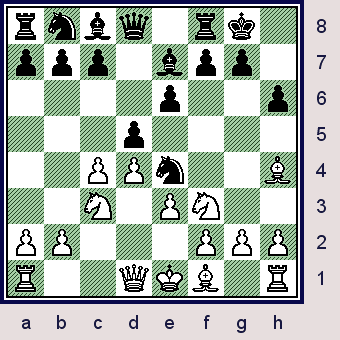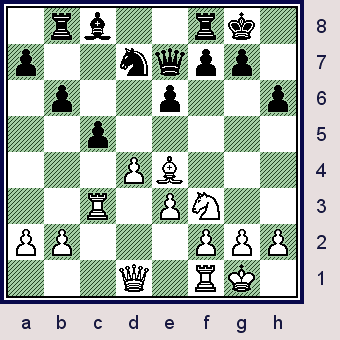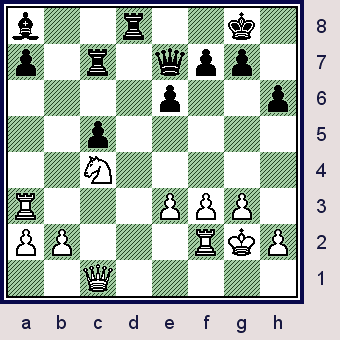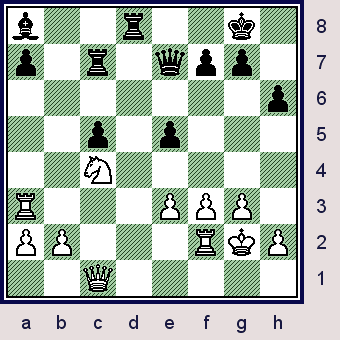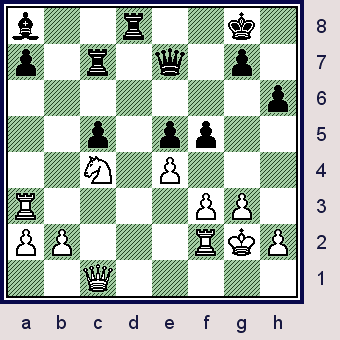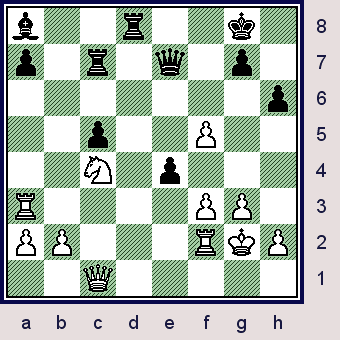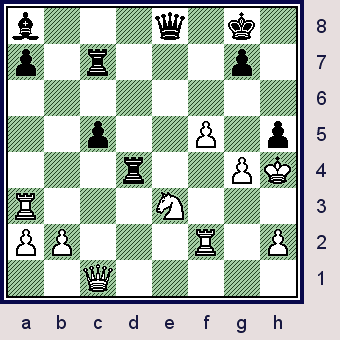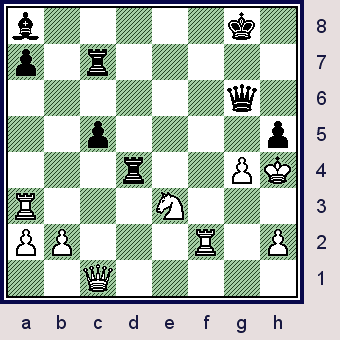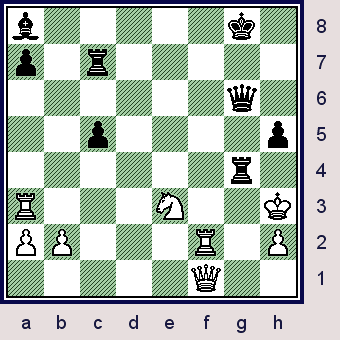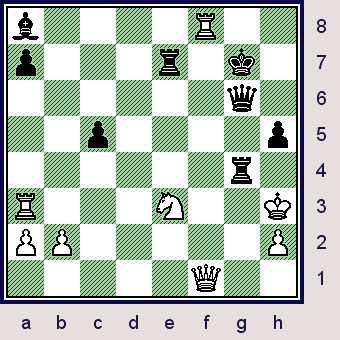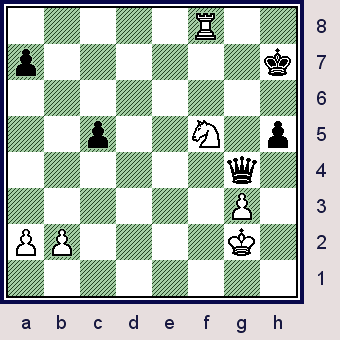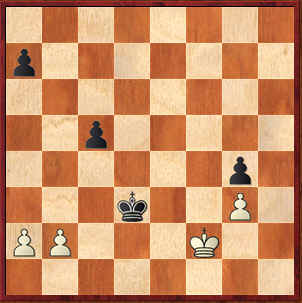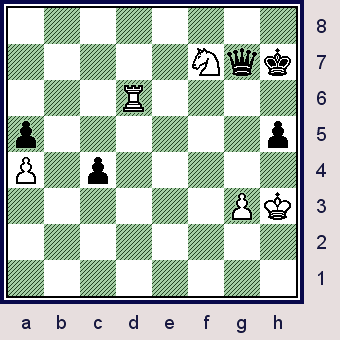All
the |
(Navigation bar
directly below.)
*******
© A.J. Goldsby, 2015.
(All rights reserved.)
****************
Click HERE
to see my
Chess Items.
****************
****************
Buy a book
from Amazon.com
(And help me out as well!)
****************
Click HERE
...
to see a list of the businesses that help to sponsor all of
my chess efforts.
WCC / Anand - Topalov; Sophia, Bulgaria, 2010.
The chess World Championships were recently concluded. (April 24th - May 13th.) It was a 12-game match, the players went into the final game, all tied up.
The
final game is
analyzed (in the box) below. (You will have to scroll down a little bit, it
below the match summary.)
(Be sure to check out the link to the ChessBase page
where GM Anish Giri analyzes this game in some detail.)
[The official site for the match.] [The TWIC initial report for the whole match.] [The CG page on this match, you can also replay all of the games.]
[ALL of the ChessBase reports on this match.] [Use Google to search the Internet for any sites, news or reports on this match.]
[ The TWIC report on the match.]
**************************************************************************************************************
The WCC 2010 ... game-by-game summary, as I see it.
I watched just about all of these games - as they were being played. Additionally, I visited almost every link or news story that had any analysis of the games themselves. So I thought you would be interested in a short description of the games ... a sort of "blow-by-blow," of the games themselves.
NOTE: Every game was a tough struggle, there was not a single GM draw! (Perhaps because of the "Sofia Rules" that were in effect?) However, it does not matter what the reason was, all that is really important is the end result. ALL of the games were fascinating to watch, not since Fischer-Spassky, 1972 has there been such a match where every game required monumental efforts from both players. (I also did not feel the need to analyze all of these games in detail, as both London's "Chess Centre" website and the "ChessBase" website often featured detailed analysis of the games themselves. Often - this analysis was posted - within just a day or two after the conclusion of each of the individual games.) Click HERE to see the page that has ALL of the ChessBase reports on this event!
Please remember that the start of the match was slightly delayed ... because all European air traffic was severely affected by a monstrous ash cloud, as there was a volcano in Iceland that was erupting at the time. [story]
-
Game One - Anand had Black and countered Topalov's QP opening with a Grunfeld. The Exchange Variation ensued, and Anand played a rather dubious line.(12...e5.) White countered strongly - with a very vigorous pawn sacrifice, and after 17.f4, it was obvious that Topalov had a powerful attack. Apparently, this was all prepared analysis, both players were moving far too quickly for this to be anything but "home prep." Anand - apparently relying on memory rather than analysis, blundered with 23...Kf7? Almost immediately, Topalov hit Black with 24.NxP/f6!!, followed by 25.Rh3! (Because that Topalov only needed a few minutes to play these amazing moves ... this proved - once and for all - that most of this game was decided in advance with computer preparation.) Anand defended about the best that he could, but Topalov played with great precision and sealed the deal, winning a truly marvelous game in thirty total moves. (1-0 in 30 moves. A real pall settled over the camp of the Anand fans, it looked like Topalov might dominate ... click here to go over IM M. Pein's comments and analysis of this game on the CB website.)
-
Game Two - I think most people expected a quiet draw ... perhaps after the horrific shock of Game One, Anand would want to take it easy in the second game of the match. However, this is not what happened! Anand played a Catalan, and sacrificed a Pawn. (This also was surely "home prep" and seemed to catch Topalov off guard.) A difficult struggle ensued ... many of the moves you really needed a computer to really understand the depth of the ideas that were played in this game. Eventually, the Queens came off and all of Topalov's supporters proclaimed victory for Black. However, it was obvious to me that Black still had a long road to trudge down before he had anywhere near easy equality. And somewhere along the way, fighting both Anand's sharp moves and also battling the clock ... Topalov made a mistake. Anand was quick to jump on this error and gained the upper hand. Eventually, when the dust settled, it was obvious that Anand was winning, Topalov resigned a hopeless R+P endgame on move forty-three. (1-0 in 43 moves. Click here to read GM A. Giri's analysis of Game Two; click here to read & go over IM M. Pein's comments and analysis of Game Two ... all on the CB website.)
-
Game Three - Topalov opened with 1.d4, and Anand countered with a {pure} Slav. (5...Bf5.) The Queens came off at move 10, however the ensuing (Queenless) middlegame/endgame was anything but easy. When Topalov played 14.Rc1, "+/=" I would say that White had a fairly large edge. The problem - for Topalov - could be summed up in the question, "How do I convert my pressure into something tangible?" This might sound easy in theory, however, in practice ... this can be a very difficult thing to do. After 19.Na4, White still had significant pressure, however, the problem of making something concrete out of this was problematic ... at best. (Another point that Topalov had to address was that the Pawn structure was completely symmetrical. As a master, I try to avoid these types of positions when I am playing a "must-win" scenario ... or when I am facing a much lower-rated opponent.) By Black's 22nd move, White's {supposed} "edge" had gone completely "flat-line." At one point, I began to think that Anand could begin playing for a win, but then Topalov played 26.c6! Now it was obvious that Black had to scramble back to equality, but Anand had no problem doing just that. Anand continued to defend - at a high level - and after forty-six moves, the final position was as drawn as it could be. (Four pawns vs four pawns on the same side of the board ... with one set of Rooks. 1/2 - 1/2 in 46 moves. Click here to see a solid analysis of the third-round game by GM A. Giri.)
-
Game Four - Once more, Anand had White and opened with 1.d4. Topalov countered with 1...d5; and once more, Anand played for the Catalan. In this game, Topalov decided to try and keep a Pawn that he won in the opening ... and really stunk up the joint, in my opinion. After 15.d5!, Black's position was a wreck, it was obvious that Black would have to give back at least a Pawn or two. After 22...Rad8, an EXTREMELY complex position had arisen, and Anand decided to sacrifice a piece with 23.NxP/h6+. (Maybe - '!!' This move is not the first choice of the machines ... but who cares?) It was obvious that Anand had a big attack, but then Topalov decided to play 25...Bxg2; ('?!' or '?'); and Anand countered 26.exf6! After this, it was a downhill slide for Topalov, right into the sewer. (He resigned at move 32, unable to ward off a certain mate. 1-0 in 32 moves, click here to read GM A. Giri's analysis of this key game.)
-
Game Five - Another White for Topalov and another pure Slav. (1.d4 d5; 2.c4 c6; 3.Nf3 Nf6; 4.Nc3 dxc4; 5.a4 Bf5.) This game was similar to game three, but here Anand probably improved by playing his KRP to h5 on move 15. Giving Topalov full credit, he generated some serious pressure ... and might have dispatched a lesser player. However, Anand defended very well, and - in the end - Topalov allowed a repetition of position. {Drawn in 44 total moves.} (The CB report contains a brief look at game five.)
-
Game Six - The first nine moves of this game were identical to game two ... so much for the on-line pundits who labeled Anand's opening as unsound and stated that he would never repeat it. (My assessment was that White had good play for the pawn, but that was about it.) This time, instead of playing 10.Bd2, Anand played the more aggressive 10.Bg5. After 14.Rac1, thought that White was OK, and several programs confirmed that fact. Then Topalov played a somewhat doubtful plan that began with 14...e5!? (As a result of this play, Black would lose back his extra Pawn.) White looked to be close to gaining the upper hand, however Anand bypassed 16.BxP/b5 for the less energetic (but safer) 16.Qc2. After this - there were many complications ... but the end result seemed to never be in doubt. Well before move thirty - I was predicting that the game would end in a draw. It eventually did end in a draw ... but not until the players had exhausted just about all of the position's resources. The game itself was quite interesting. Normally two Bishops are vastly superior to two Knights, here the two Knights seemed to enjoy all the play. One curious feature about this game was that White had a Knight ... that was fearlessly was hopping all over the board. (1/2-1/2, 58 moves, the CB express report of this round.)
-
Game Seven - Anand is White, (a swap of colors for the second half of the match); so it seems we will have another Catalan opening. (1.d4 Nf6; 2.c4 e6; 3.Nf3 d5; 4.g3 Bb4+; 5.Bd2 Be7; 6.Bg2 0-0; 7.0-0 c6.) Black was fine out of the opening, maybe White has a slight pull. Anand played 8.Bf4, and (once more) Topalov could not resist the temptation to grab the c-pawn. Anand would up winning the exchange, yet Topalov had play for his lost material in the form of a Pawn and also the fact that White had lost his light-squared Bishop. Topalov proved himself a top-notch chess player by stirring up a mess of wild complications, no easy "swap-and-win" policy here for Anand. (This game features a distinct MATERIAL IMBALANCE, students of the game should study it carefully to try and gain an understanding of these types of positions.) White (Anand) erred slightly by playing 21.Kh1, better was 21.Kg2. Although seemingly a natural play, 25.Nd2 might have been a real bad move ... because suddenly the computer's evaluations had shifted dramatically. All of a sudden, Anand - instead of playing to win - was struggling to simply hang on and even had to find some really accurate moves just to avoid losing. For many moves, all Topalov had for a Knight was one single Pawn, yet (in retrospect) Anand never seemed to be close to winning. After 58 exciting moves, it had become obvious that even though White was a piece ahead, he could not force a swap of the Queens that was needed to try and win. (Drawn in 58 total moves.) Black's dangerous passed d-pawn and piece activity were more than enough to hold the balance. (See this page for CB's quick analysis of this game.)
-
Game Eight - Once more, Topalov is White, and he opens with 1.d4. Another (pure) Slav unfolds, the opening here (up to 13.BxP/c4) is identical to games three and five of this match. However, Topalov hits Anand with a new move, (15.BxN/d7+!); and Black never quite seems to fully equalize. This game also proves that - sometimes - the computers don't know squat about positional chess. Black plays a whole series of positional concessions, (Black plays ...f5?!; and allows a alter e4-e5. Later he plays ...f5-f4?; {to free his QB}; but this only dumps a Pawn.); in an effort to gain counterplay. (Many of Black's moves were OK to the machine, yet Black got into serious trouble.) After 32 moves, Black found himself in virtual ZUGZWANG and had to lose a Pawn. In addition to this, Anand swapped on d6 ... giving White a passed QP ... when he absolutely did not have to. And there were several other moves (like ...g6?); that I did not approve of. However, all of this was esoteric ... ... ... it was a "Bishop-of-opposite-colors" endgame, and therefore a draw should have been the only correct result. After 53 moves, Topalov played Kf4, and the game could have been drawn here. However, Anand played 53...Kf7?; retreating his King for NO GOOD REASON {that I could see}. And even this was not enough to blow the draw! However, on his next move, Anand played a real HOWLER ... a virtual "Class-C" move with 54...Bc6??? (Simply >/= 54...Bd3; followed by 55...Ke8; and 56...Kd7; would have easily held the draw.) A few moves later, Anand felt compelled to RESIGN, and this tied the score of the match. (1-0 in 56 moves. Click here to see ChessBase's analysis of the game.)
-
Game Nine - Perhaps tiring of the Catalan, today the champ trotted out a different opening, which resulted in a solid line of the Nimzo-Indian. (1.d4 Nf6; 2.c4 e6; 3.Nc3 Bb4; 4.e3 0-0; 5.Bd3 c5; 6.Nf3 d5; 7.0-0.) However, Topalov avoided the safe and solid 7...Nc6; and decided to give Anand an isolated QP with 7...cxd4; 8.exd4, dxc4!? According to the machine(s), this gives White a substantial edge, yet Black might be playing for the win ... because - much later on in the game - White's isolated QP could prove to be a real weakness for White. Somewhere over the next few moves, Anand must have misplayed his hand, because after 18...e5; Black looked to have equalized completely. Then on move 20, Topalov played 20...exd4?!; instead of safer/tamer 20...Nhf6; and this gave Anand the chance to give up his Queen for two Rooks. What followed now was thirty moves of bizarre and mind-boggling complications. Eventually Topalov lost his Knight as well. This left White with two Rooks and a Knight (and one Pawn) for Black's King, Queen and two pawns. However, both of Topalov's Pawns were connected and passed on the a & b-files, which meant that Black's game plan was pretty simple: to wit, all Topalov had to do was shove his Pawns down the chessboard! Meanwhile, Anand was fighting not only a tough opponent, but also had fallen behind on the clock as well. In the end, Anand missed many wins, and the game boiled down to an absolute draw where White had a King and two Rooks, but not enough cover to hide his King from all of the checks that the lone Black Queen could deliver. [Drawn in a titanic struggle of eighty-three (83) total moves, the longest game of the whole match. Click here to see the link for CB's analysis of this game.] I also have done a brief analysis of this game, it {also} shows just how many wins Anand missed.
-
Game Ten - Much excitement among the on-line kibitzers today, we return to the scene of the massacre in Game One! (Anand repeated his opening of that game, the Exchange Grunfeld.) After 30 moves, White had a Passed QP and two Bishops, and all the engine-heads were telling us that it was all over ... Rybka had already found the win. Of course this was nothing more than powerful jaws flapping uselessly in the breeze, because Anand defended stoutly and soon Topalov ran completely out of gas. (Nigel Short's comments for the CG website were right on the money in this game.) Anyway, after 60 moves, it became obvious that it was a draw and not even the mighty Topalov could dispute this. (1/2-1/2 in 60 moves - click here to see CB's coverage of this round, which includes a very quick analysis of this game.)
-
Game Eleven - Anand was White, and this time the champ went for a completely different opening, THE ENGLISH! (1.c2-c4, e7-e5) What resulted was a reversed Sicilian Dragon. After 11.Ne4, I felt that White had a slight edge, although the box sees it as close to completely equal. However, I felt that Anand's 12.Nc5!? was completely wrong, anti-positional and went against everything I had ever learned about these kinds of Pawn formations. (It eventually resulted in a bad endgame for White.) Normally, White wants to outpost a Knight on c5 and keep the c-file open, not close it! Anyway, after the smoke cleared, Anand was left defending a slightly inferior endgame. It turned out that - in the long run - White's lone Pawn on b5 was as much of a weakness as anything else. And with his 49th move, (Rd2!?); Anand decided to stop trying to defend the Pawn and see if he could get some counterplay instead. Of course, the engine-heads gleefully declared that Black was now winning easily, however, I went on record predicting that the worst Anand could do was draw the game. In the end, Topalov never came close to winning, and after Anand made a dangerous, passed g-Pawn ... and also had the much more active King ... Topalov was forced to allow the draw. (1/2 - 1/2 in 65 tension-filled moves. Click here to see GM A. Giri's very carefully done analysis of this game.)
-
Game Twelve - I have analyzed this game just below. Suffice it to say that Anand played well and Topalov severely misjudged the consequences of his 31st and 32nd moves. Topalov did the best that he could to try and defend his position, however, nothing was going to save the Bulgarian's hide on this day. (Black won, 0-1, in 56 heart-stopping moves.)
Some things you need to know.
Please
remember the following fact - although it is not stated anywhere below.
I have several
ideas in mind when making a web page:
-
It should look good, I should be proud to add it as one of my web pages.
-
The analysis has to be correct and will have been checked by the strongest chess engines ... MANY times!!!
(Sometimes I will spend days ... or even weeks ... preparing my analysis of a game. For this game, I used many different engines to test and verify my work.) -
Sometimes less is more. (The "KISS" method, or "Keep It Simple," ... ) In other words, when many other web pages have already analyzed a game, I feel it is a waste of time to repeat every single variation that they might have quoted about a game before.
-
There should be as many diagrams as possible. Maybe not one after every move, but the average player can hopefully follow the game even if that person does not have access to a chess board ... simply by following the diagrams. (Of course having and using a chess board is better and will make it easier to go over the variations.)
-
Its nice to check out the links, but the web page should stand alone. In other words, the average player - even if they never visit another web page - they should get fair idea of the game and the tactics simply by going over my version of the game. (This does mean that repeating a few lines may be necessary for the web page to stand alone as an individual piece of analysis.) Basically, as much as possible, this means that - in addition to the analysis - that the page should include as many facts and links as possible. More importantly, the web page (in question) should "tell the story" of the game, the reader should get some sense of the events that occurred during the game. I.e., if the web page is done extremely well, the reader should almost get a sense that they were there during the game itself.
However, the most important thing to me ... and this is NOT important to other websites ... is that even a "BARE-BONES BEGINNER" should be able to follow the game. In other words, if a person sets up a board and endeavors to follow the game, there should be enough explanations that even a novice will not feel lost. (I think its important to remember that the majority of the world's population will never spend the time on chess beyond learning the basics of how the individual pieces move. This is why I spend so much time on layout and making sure it is obvious what are the actual moves of the game and what the variations are.)
GM V. Topalov (2805) -
GM V. Anand (2787)
|
|
|
|
Click here to see an explanation of all the symbols that I commonly use when annotating a game. Click here to re-play this game ... on another server. (This is not my site, please do not write me about the content!) |
The final game of the Anand-Topalov (2010) World Chess Championship Match. I thought that I would lightly annotate this game and bring it to my fans and all of my readers. [I watched this whole game online ... mainly from the live coverage of the "Chess Games" website. I also had a guest account on ICC and I watched the coverage of the "Play-Chess" server as well. I was in constant communication - with many of my chess friends and students - through my cell-phone, and also the Windows Instant Messaging system. ... ... ... It was a blast!!!]
The score was all tied at 5.5 each. It seems apparent - from the way that Topalov conducted this game - that he did not want to face Anand in any kind of quick/rapid chess. I fully expected Topalov to go "all out" in this encounter ... and he did.
My goal was to present a simple and streamlined analysis ... and possibly point out those things not mentioned by other annotators. For a detailed look at this game, please see A. Giri's excellent analysis of this game on the CB website. (http://www.chessbase.com/newsdetail.asp?newsid=6327) Additionally, I definitely wanted to look at any lines or variations that perhaps Giri did not cover in his initial article.
As well as the goals and ideas outlined above, I also wanted to point out some of the main lines of the Q.G.D. and possibly point the aspiring student in the right direction. (I wanted to give a basic roadmap of all the main lines of the Queen's Gambit Declined. Any chess players - who are really interested in learning the Queen's Gambit - should check out the following page: http://www.angelfire.com/games3/lifemasteraj/capa-alek1_1.html. This might be the most heavily analyzed {single} game on the whole of the world-wide-web.)
*********************************************************************************************************
1.d4,
Of course 1.d2-d4 is not a bad move, in fact it is an excellent one. However, I strongly feel that Topalov (and his
team) had failed completely in their pre-match preparation.
What is the reason that I say this? It seems (to me) that they did not have any really new ideas, and the Queen's Gambit has not been a giant success for Topalov in this match. Further, if GM V. Kramnik could not succeed in defeating Anand after 1.d4, d5; then what chance did Topalov really have?
[ Topalov should have tried 1.e4, at least one time in this match. ]
Both sides conduct their opening
while closely observing the four main principles of the
opening.
1...d5;
2.c4 e6; 3.Nf3 Nf6; 4.Nc3 Be7; 5.Bg5 h6; (Queen's
Gambit Declined.)
Black signals at least part of his intentions. (Lasker or TMB system.)
[ The main line is: 5...0-0; 6.e3 Nbd7; 7.Rc1 c6; 8.Bd3 dxc4;
9.Bxc4,
when Black would probably play the
"Capa freeing maneuver" that
begins
with 9...Nd5.
[ For more info and analysis, please see MCO-15, pg. # 595, columns #1 - 6. ] ]
Here Topalov (and his team) should
have seriously investigated 6.BxN/f6.
(Garry Kasparov successfully used this move on a number of occasions.)
6.Bh4,
The main line ... and all that.
[ A solid alternative was: 6.Bxf6!?, please see the interesting contest:
GM Bu Xiangzhi (2710) - GM Rafael A. Vaganian (2594); [D55]
ICT/ InventiChess
/ Antwerp, (R#6); Belgium / 2008.
{White won, 1-0 in 35 total
moves.} ]
6...0-0;
7.e3 Ne4;
Anand's intentions are revealed. (This is the Lasker's Defence, one of the most solid lines in all of chess.)
|
|
rnbq1rk1/ppp1bpp1/4p2p/3p4/2PPn2B/2N1PN2/PP3PPP/R2QKB1R; White - 08.
For more analysis and info, please see MCO-15, page # 406, and columns # 31 through 36.
[ A major alternative was to play: 7...b6!?; (The T.M.B. System) ...
{T.M.B.
= Tartakower-Bondarevsky-Makoganov.}
See MCO-15, pg. # 412, col's 43-48.
The TMB was a favorite of Spassky's ... and later, Anatoly Karpov used it many times -
with tremendous success.
(Click here
to see one game - between two highly rated players -
where
Black used this opening ... and met with success.)
Click here
to see one web page that I have done about a game where the players used
this line ...
(the T.M.B. opening system in the Queen's Gambit Declined). ]
8.Bxe7,
This is virtually forced.
[ RR Instead, after the
continuation of:
8.
Nxe4!? dxe4; 9.Bxe7 Qxe7; 10.Nd2 f5;
"~" (Maybe - "=/+")
and Black has no problems at all.
]
8...Qxe7;
9.Rc1 c6;
10.Be2 Nxc3;
A fairly modern idea.
[ When I was a teenager, some 35+ years ago, I bought a huge book on the QGD.
(Of course, it was in descriptive notation!)
Back then the main line was:
10...Nd7;
11.0-0 Nxc3; 12.Rxc3 dxc4; 13.Bxc4, "+/="
13...e5;
when Black can usually equalize.
For an excellent example - by a {former} World Champion - please see the following clash of titans:
GM Anatoly Karpov (2755) - GM Arthur Yusupov (2610); [D56]
FIDE Candidates (sf1) / Match Game #7 /
London, ENG; 1989.
{White gave a chess lesson that day, 1-0 in 53 instructive moves.} ]
11.Rxc3,
The most common - and probably the best - reply. (White activates a Rook and pressures c5 as well.)
[ A second {viable} possibility was: RR
11.bxc3!? Rd8; 12.0-0,
"+/="
when most of the major engines show a fairly solid edge for White.
]
*****************************************************************************************************************************************************************
Both sides continue with their development.
(In the meantime, Black is working hard to get in one of his pawn breaks, which are ...c6-c5 or ...e6-e5.)
11...dxc4; 12.Bxc4 Nd7;
13.0-0 b6!?;
This is a relatively new line for Black, however it is mentioned in many of the standard opening texts.
[Reference MCO-15, pg. # 406, column # 33.]
The other two main alternatives would be 13...e5; and 13...c5.
14.Bd3 c5;
15.Be4, "+/="
White is trying valiantly to make inroads to Black's position.
[ Less effective would be: RR 5.dxc5 Nxc5; 16.Ne5, "=" when Black is OK. ]
15...Rb8;
A critical position has been reached.
|
|
1rb2rk1/p2nqpp1/1p2p2p/2p5/3PB3/2R1PN2/PP3PPP/3Q1RK1; White - 16.
White is slightly better, however, Black has good chances to equalize.
***************************************
Now a DVD on this opening recommends 16.Bc6, while the top choice of the CB/Fritz "Power-Book" is 16.Qa4.
16.Qc2!? Nf6!;
Black plays for dynamic piece activity ...
in the style of Garry Kasparov.
<< An idea from the Polish player, Grabarczyk, which was probably a surprise for Topalov. 16...a5 was used to be one of the main moves here, as well as Bb7 and Ba6. >> -- GM Anish Giri ( -----> From the CB website. )
Now Topalov chooses to give up his Bishop, however, in return, he saddles Anand with an isolated QBP.
17.dxc5 Nxe4; 18.Qxe4 bxc5; 19.Qc2, (Looking at Q-side play.)
"Toppy" chooses to immediately begin stacking up on the Black c-Pawn.
[ The alternative was: RR 19.b3 Bb7; 20.Qf4, "+/="
GM Kaido Kulaots (2531) - GM Miroslaw Grabarczyk (2510); [D56]
3rd Borup
Open, (R#6) / 12,09,2008.
{Drawn in less than 35 moves.} ]
19...Bb7;
20.Nd2, ("Box?")
This was more or less forced.
(White did not want to allow Black to play ...BxN/f3 and wreck his K-side.)
[
Instead, after the following moves:
</=
20.Rxc5?! Bxf3; 21.gxf3 Rxb2!;
22.Qxb2 Qxc5; "=/+" (P-structure)
and now - according to Fritz - Black is slightly better.
]
20...Rfd8;
(center / mobility)
Now this is the current position, and it is time to try and assess or evaluate the outcome of the whole (of the) opening.
|
|
1r1r2k1/pb2qpp1/4p2p/2p5/8/2R1P3/PPQN1PPP/5RK1; White - 21.
White has the better structure, Black has good play for his pieces. I see it as a tiny edge for White, Fritz 12 calls it dead even.
************************************************************************************************************************************************************
Now White plays to blunt the Black Bishop ... staring at his King down the long (light-squared) diagonal.
(This is OK ... and even good for White.)
21.f3!?
Ba6N; (Maybe - '!')
The first new move of the game.
Its logical, since White has blocked his Bishop's pathways on one vector, Anand immediately seeks new horizons for his Bishop -
on a new diagonal.
22.Rf2
Rd7;
(Probably - '!')
Anand could choose many different plans and piece set-ups from this position. For me, doubling the Rooks was one of the most simple, flexible, and direct ... and quite possibly the best.
23.g3?!,
(ANTI-POSITIONAL)
Bad - according to common chess thoughts here. (Black has a light-squared Bishop. The last thing that I would want to do in such a position is to start drilling holes around my own King ... on this same light-colored complex of squares.)
"In today's times and in the modern era of chess engines, no one cares anymore for general principles." - GM Nigel Short.
[ >/= 23.Nb3 Rbd8; 24.Rd2; "~" - Fritz 12. ]
23...Rbd8;
24.Kg2 Bd3!;
An important move for Black, the fact that the WQ is more out of play on c1 (than on c2) will become blatantly obvious as the game proceeds.
25.Qc1
Ba6; "~" (Unclear?)
Objectively, the engines call this position dead equal ... ... ...
but maybe its only a balanced position, as long as you can play as well as a machine!
26.Ra3!?
Bb7!;
Black sets a small trap ... (</= 27.RxP/a7??,
BxP/f3+!); however, he has also returned his Bishop to the ... LONG DIAGONAL!
(Please note that this tactical theme ... of White being unable to
capture on a7 because of the discovered check on f3 ... will persist for several
more moves here.)
Now Fritz recommends 27.e4!. "+/="
27.Nb3!? Rc7; 28.Na5 Ba8!;
29.Nc4, (Outpost!?)
Topalov seems to have no clear plan, his Knight is just sort of wandering around the Q-side. (GM N. Short even made a remark as regards this point, while acting as the chief commentator on this game for the
CG website.)
|
|
b2r2k1/p1r1qpp1/4p2p/2p5/2N5/R3PPP1/PP3RKP/2Q5; Black - 29...
Now according to the engines ... and I let a few run all night in this position ... ... ...
White has a tiny bit of an edge.
[ </= 29.b3? Rcd7; 30.Nc4 Rd1; "=/+" ]
Black to move here.
29...e5!;
(Stealing the initiative.)
Anand - with about 30 minutes left on the clock to get to move forty - played this move fairly rapidly.
|
|
b2r2k1/p1r1qpp1/7p/2p1p3/2N5/R3PPP1/PP3RKP/2Q5; White - 30.
The main reason that this move is so good is that:
A.) The White Knight is severely restricted now by Black's Pawn structure.
B.) The button threatens to run to e4 and rip White up on the light squares.
White's response is pretty much forced in this position.
30.e4[]
f5!; (Pawn sacrifice.)
Crunch time.
|
|
b2r2k1/p1r1q1p1/7p/2p1pp2/2N1P3/R4PP1/PP3RKP/2Q5; White - 31.
In a difficult position, Black tempts White with the offer a Pawn ... and only an insane man would accept.
Anand is quite happy and in his element.
(He is on the offensive, and he is about on par with Topalov as regards the amount of time left on the chess clock.)
31.exf5?!;
(Maybe even - '?')
I had just finished explaining to a {former} on-line student why this move was bad ... when Topalov played it!
[ >/= 31.Nd2[] fxe4; 32.Nxe4 c4; 33.Re3 Rd3!; "=" - Fritz 12. ]
31...e4!;
(attack - light squares)
Now Anand is breaking through.
|
|
b2r2k1/p1r1q1p1/7p/2p2P2/2N1p3/R4PP1/PP3RKP/2Q5; White - 32.
This is the current position.
32.fxe4?,
('??' - GM Anish Giri.)
This turns out to be simply suicide, one can only guess as to what went through Topalov's mind that allowed him to play such a move!
According to just about all the chess engines, White is now lost ... and nothing can save Topalov's game.
[ >/= 32.Kh3[] exf3; 33.Nd2! Qg5; 34.Qc4+ Rf7; "=/+" 35.Qg4, - Fritz 12. ]
32...Qxe4+;
33.Kh3 Rd4;
This threatens 34...Qg4#, by now it was obvious to most folks that Black has a powerful - and probably a winning - attack.
34.Ne3[],
This was 100% forced.
|
|
b5k1/p1r3p1/7p/2p2P2/3rq3/R3N1PK/PP3R1P/2Q5; Black - 34...
Now Black has many ways of continuing assault, but only one way is best.
[ Much worse was: </= 34.Rf4?! Qg2+, "-/+" and the box sees mate. (U20) ]
Black to move.
34...Qe8!; (Maybe - '!!')
Not just threatening mate in one, this re-deployment of the Queen seals White's fate.
GM A Giri liked this move so much, that - on the ChessBase website - he awarded this move TWO exclams!
35.g4T, (Completely forced. "Box" or
[].)
This was the ONLY move for White! (There was no way that Topalov would start playing "give-away" in this position!)
35...h5!;
(X'ing the Pawn shield.)
The most forceful move, Black rips away the few remaining foot-soldiers that might (try to) defend the hapless White Monarch.
36.Kh4!,
(Best!)
You have to give Topalov credit, it must have taken nerves of steel to advance your King UP the chess board in a situation like this.
(Several engines confirm that this is White's best move.)
|
|
b3q1k1/p1r3p1/8/2p2P1p/3r2PK/R3N3/PP3R1P/2Q5; Black - 36...
Once again, it was Black to move, and Anand had to find a good way to continue his attack.
[ After the following continuation: </= 36.Rc3? hxg4+; 37.Kh4 g5+!; "-/+" its mate in 13 - according to Fritz. ]
36...g5+!;
Maybe the best practical move here for Black.
[ GM A. Giri did not look at this line in his initial article, so I felt that I had to explore it:
Best was: >/= 36...Qd8+!!; 37.f6[];
This is - of course - forced here.
(Even worse was: </= 37.Kg3? Qd6+; 38.Kh3 Qh6; "-/+")
37...hxg4; 38.Rf5 gxf6;
39.Nxg4 Rh7+; 40.Kg3 Qb8+!; 41.Rf4 Rxf4;
42.Qxf4 Rh3+!;
43.Kxh3 Qxf4; "-/+"
and Black is winning easily.
However, this line was much more complicated than what was played in the actual game.
(Additionally, it had many branches that I did not explore.) Therefore I feel that Anand made
the best decision - given the situation on the chess board AND the clock!
]
37.fxg6[],
("Forced," or "only move.")
Anything else loses horribly.
[ The button on g5 is poisoned: </=
37.Kxg5?? Rg7+; 38.Kh4 hxg4; "-/+"
and White is worse than lost.
]
37...Qxg6;
Now the BQ is just two squares away from the White King ... ... ...
|
|
b5k1/p1r5/6q1/2p4p/3r2PK/R3N3/PP3R1P/2Q5; White - 38.
I would not want to even try and defend this position as White.
White to move here.
38.Qf1!, (Best - Fritz 12.)
I was NOT looking at any analysis engines at this point ... and I did not think much of this move when Topalov first played it.
However, (once more); you have to give the "Dark Knight" credit, he continues to find the best defensive moves to try and hold his position together.
[ </= 38.Rc3? Rxg4+!; 39.Kh3 Rg7; "-/+" ]
38...Rxg4+!; 39.Kh3[], Forced.
|
|
b5k1/p1r5/6q1/2p4p/6r1/R3N2K/PP3R1P/5Q2; Black - 39...
Now what is the best way for the Indian Champ to continue?
[ Of course not: </= 39.Nxg4?? Qxg4#. ]
39...Re7!!;
(1st choice - Fritz 12.)
Once more, Anand also proves his mettle ... and finds the move that all of the chess engines show as being best for Black.
[ RR A nice "fantasy mate" ... that I calculated OTB while watching this game ... was:
39...Rf7!;
40.Rxf7 Bg2+!!; 41.Nxg2[] Rh4+!; 42.Nxh4 Qg4#.
]
40.Rf8+,
(A spite check?)
Topalov continues to hang in there ... and try to make things as difficult for Anand as possible.
|
|
b4Rk1/p3r3/6q1/2p4p/6r1/R3N2K/PP5P/5Q2; Black, 40...
Once more, Anand has to find the best move in this position.
[ RR 40.Qd1 Rd4!; 41.Nf5 Qxf5+!; 42.Rxf5 Rxd1; "-/+" ]
40...Kg7!;
(Take my Bishop, please?!?)
The best practical solution, especially as this was the last move of the game before the time control was reached.
(Anand did not have much time left on his clock.)
|
|
b4R2/p3r1k1/6q1/2p4p/6r1/R3N2K/PP5P/5Q2; White - 41.
Now I believe that the time control had been reached and both players got another hour on the clock.
[ In my opinion, there was no chance any human could find the following continuation for Black;
especially seeing
that both parties were running short of time at this point:
>/= 40...Kh7!!; 41.Rh8+! Kxh8;
42.Qf8+ Qg8!; 43.Qxe7!? Bg2+!!;
44.Nxg2 Qc8!;
45.Nf4 Rg6+!;
46.Ne6 Rxe6; 47.Qg5 Re3+!;
48.Kg2 Qh3+; 49.Kg1 Re1+;
50.Kf2 Qf1+;
51.Kg3 Qg1+;
52.Kf4 Qd4+; "-/+"
when several engines confirm that White will be mated in 10-15 moves.
]
The game now quickly winds down, there is little else of great interest. Now its just a matter of technique ...
and Black has the rather pleasant task of trying ... "to win a won game."
41.Nf5+!?,
"Toppy" continues to try and mess things up ... ... ...
[ The Bishop on a8 was off limits: </=
41.Rxa8? Rxe3+!; 42.Rxe3 Rh4+!;
43.Kxh4 Qg4#. (Cascade mate.)
I commented on this possibility immediately after the 39...Re7!!; move was made.
]
The next few moves all appear to
be forced, or are very close to the best that either side can play.
41...Kh7!;
42.Rg3 Rxg3+;
43.hxg3 Qg4+; 44.Kh2 Re2+;
45.Kg1 Rg2+!; 46.Qxg2 Bxg2; 47.Kxg2, (ugh!)
This looks like a mistake ... but the other path was even worse! (See the variation given - just below.)
|
|
5R2/p6k/8/2p2N1p/6q1/6P1/PP4K1/8; Black - 47...
At this point, I knew that the game was over. The only question in my mind is: "When would GM V. Topalov resign?"
[ RR The K+P endgame after: 47.Rf7+
Kg6; 48.Rg7+ Kxf5; 49.Rxg4 hxg4;
50.Kxg2
Ke4; 51.Kf2 Kd3; "-/+" is completely hopeless for White.
{See the analysis diagram - just below.}
(8/p7/8/2p5/6p1/3k2P1/PP3K2/8; White - move # 52.) |
---> Worse, it is so simple, that there
is no chance that Anand might make a
major error in this position.
]
Now Anand wraps things up.
(His technique was absolutely superb. More than once, Anand used the weapon of Zugzwang to break down Topalov's resistance.)
47...Qe2+;
48.Kh3 c4!;
49.a4 a5; 50.Rf6 Kg8!;
51.Nh6+ Kg7; 52.Rb6 Qe4!;
53.Kh2 Kh7;
54.Rd6 Qe5!;
55.Nf7!? Qxb2+; 56.Kh3 Qg7!; "-/+" White
Resigns.
The main point was that 57.Rd7, is refuted by 57...Qg4+; and then 58...QxR/d7.
(The Black Pawn on c3 will eventually cost White his Rook.)
|
|
8/5Nqk/3R4/p6p/P1p5/6PK/8/8; White - 57.
A wonderful game by Black, who played with a sure hand throughout the whole of the entire contest. A grand game to finish off a well played match, my hearty congratulations to GM V. Anand for successfully defending his title as Chess's World Champion.
Copyright (c) A.J. Goldsby, 2010. All rights reserved.
0 - 1
The analysis of this game was done with the program, CHESSBASE 10.0. (I used MANY different analysis engines, to include Rybka, Deep Junior, etc. However, my main engine - for this game - was Fritz 12.)
Click
HERE
... ... ... to go to a website where I analyze many games in detail. (Its
my old, "Game-Of-The-Month" website.)
(If you don't have many opening books, then this would be a
good site to visit. The primary emphasis here is on opening analysis, and
learning the plans and ideas of a specific opening. There are also many
good links and most games have multiple diagrams. There are generally
links to replay pages as well.)
-----> This page is mentioned in an Impala blog entry.
Click HERE to return to my home page.
Click HERE to go/return to my "Best Games" page.
Click HERE to go/return to my "Site Map." page.
This page was first prepared in the early part of May, 2010. It was first posted on
Friday; May 14th, at 01:15 AM.
The final format was completed on May 21st, 2010. This page was last altered on Tuesday, April 28, 2015 02:04 PM
.
Copyright (c) A.J. Goldsby I
Copyright (©) A.J. Goldsby, 1985 - 2014.
Copyright (©) A.J. Goldsby, 2015. All rights reserved.
|
|
